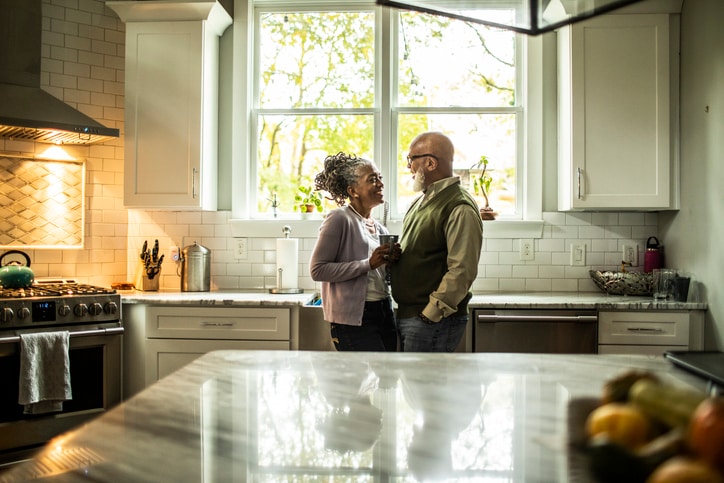In this article
If you are interested in a senior living option that combines freedom, support and social opportunities, independent living might be just what you’re looking for.
“Independent living is a housing option for seniors who are mostly self-sufficient and can manage their day-to-day activities,” Dr. Snehal Smart, physician and patient advocate at The Mesothelioma Center “They can take care of themselves with small tasks and are otherwise healthy or physically active, and they want to enjoy socializing and taking part in community activities.”
But there’s more than just one kind of independent living. Here, we’ll go over what independent living for seniors looks like, the benefits and what to know about the different options.
Key takeaways
- Independent living for seniors include various housing communities designed for seniors who are still able to live on their own
- Benefits of independent living options are that they provide extra safety, convenience and more opportunities for socializing.
- Meeting with a geriatric care manager or geriatric social worker can help shed light on what type of living situation makes most sense for your situation.
What is independent living?
Terminology for senior living can be confusing because there’s often variation in how each state, community or expert defines different senior living options, says Brett Koenig, managing partner at Senior Living Search Partners. “I would define independent living for seniors as communities that, for the most part, offer private apartments in a setting which provides housekeeping, meal services and a number of other convenience services like transportation, laundry and so on,” she says.
Independent living is typically for seniors who don’t need much extra help with the activities of daily living, such as dressing, bathing, medication management and ambulating. Independent living communities also don’t usually provide care for dementia patients.
But we all know that life can change, and needs may increase as you age. Families frequently ask Koenig if independent living is the right choice for a loved one who needs some extra assistance, or who may need more assistance in the future. It depends largely on the independent living community, she says.
“While the name ‘independent living’ does give the impression that all of the residents are completely independent, many communities work hand-in-hand with home care services, so there can be a degree of flexibility,” Koenig points out.
“While the name ‘independent living’ does give the impression that all of the residents are completely independent, many communities work hand-in-hand with home care services, so there can be a degree of flexibility.”
— Brett Koenig, senior care specialist
Types of independent senior living
Independent living options for seniors can vary quite a bit from one facility to another. Koenig shared thoughts on the different independent living communities out there.
- Senior apartments
- Retirement communities
- 55+ communities
- Continuing care communities (CCRCs)
Costs and payment options for independent living
The cost of independent living varies widely based on type and location. Some communities require entrance fees plus monthly rent, while others are strictly rental-based. On average, seniors who choose independent living can expect to pay between $2,500 and $8,000 per month, depending on the location and type of community.
Costs for independent living communities typically include things like housing, meals, utilities, housekeeping and social activities. However, if you or your loved one need more support — such as with activities of daily living, like bathing, dressing or mobility — you should expect to pay more.
Keep in mind, too, that these are usually out-of-pocket costs. Medicare typically does not pay for independent living communities. Long-term care insurance might be helpful, but it usually only kicks in once the recipient needs help with the daily tasks of living.
Many use personal funds to cover independent living costs. For example, if you sell a home to move into an independent living community, you could use the proceeds from your home sale to pay for it.
Benefits of independent living
According to the experts we spoke to, there are many benefits to joining an independent living community, including:
- Built-in safety features.
- Convenience.
- Socialization.
- A strong sense of community.
- Fewer home maintenance responsibilities.
- Access to planned activities.
Still, independent living communities aren’t for everyone. In most cases, independent living is not ideal for seniors who:
- Need intensive daily personal care.
- Need intensive medical support.
- Have moderate to severe dementia.
- Have severe mobility limitations.
At the same time, each independent living community is different, and some may be able to offer more specialized care than others. In particular, CCRCs typically offer more intensive support as you age. It’s important to vet each community thoroughly and make sure you have a clear understanding of every option available to you.
How to know if independent living is right for you or an aging loved one
Making a decision about where to live when you get older can be challenging and overwhelming, but help is out there if you need it.
Meeting with a geriatric care manager or geriatric social worker can help shed light on what type of living situation makes most sense for your situation. They can help you consider both your current and future care needs, social preferences and any medical conditions that may require assistance now or down the road. They can also help you figure out which community works best for your budget, and what amenities and perks would be most useful and meaningful to you.





